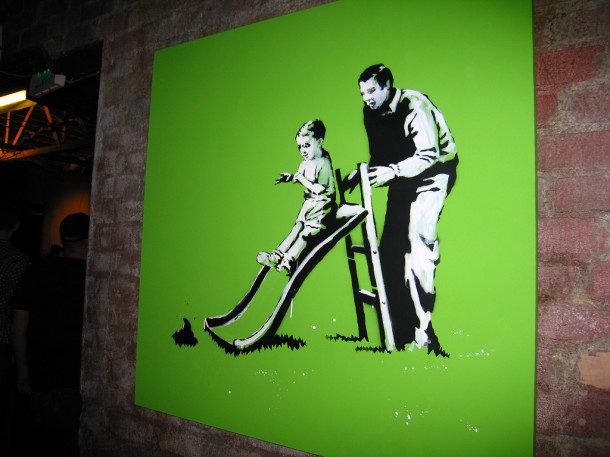U.S.A. The street artist scribbled in his notebook and spoke without looking up: “The beauty of art throughout history is that it records where we are and where we come from as people, the resilience of the human expression.”
Adam Rodriguez, 24, has been a political artist for most of his life. Over six years ago, Rodriguez moved to San Francisco from Indio, California, sacrificing everything to paint in the street and network with other artists.
“There is a series that I have been working on for a while having to do with social media’s influence in our culture and it’s almost dogmatic, religious qualities,” said Rodriguez. “I make references to religious iconography and social media symbolism, for example, Jesus Christ crucified on the Facebook logo, as a way to draw the similarities between the two institutions that influence our society so heavily.”
Artists like Rodriguez strive to shine a light on social issues through the use of symbols and iconography. The anonymous artist Bansky, is well known for this stencil style street art of political and social commentary that has been appearing around the world and causing people to stop and think about the political realities of today’s world.
“He is a satirical, political, innovating graffiti artist,” said Elijah D’Arcy, senior Design student at the University of San Francisco. “One of my favorite pieces is one of a leopard breaking out a bar code/cage. I took it as a message that society has turned us all into caged animals and it is up to us to break free.”
“Street artists like Banksy have made an impact in popular culture because of their ability to relate to other people’s understanding of the human condition in the current times,” said Rodriguez, “Artists have to be the voice of the people, to speak for those who can’t speak for themselves.”
Street art gained popularity in the U.S. during the 1980s when graffiti started to make a presence in cities. This type of art is usually illegal..”
According to shouselaw.com, “Penal Code 594 PC, California’s vandalism and graffiti law, prohibits maliciously doing any of the following things to someone else’s property: Defacing it with graffiti or other written material, damaging it, or destroying it.” Vandalism is considered a felony if the damage is worth more than $400.
The intent of street art is that the message will communicate directly with the public and attract attention to an issue as a form of art provocation. In a country that values freedom of speech and prides itself on housing some of the world’s most iconic artworks, how does one make the distinction between political art and vandalism?
The San Francisco Public Works Office offered no comment.
“I consider Banksy’s work and other’s like it art,” said Megan Wilson, artist and Core Organizer for the Clarion Alley Mural Project in San Francisco. “The difference between art and vandalism is intent. Is the act one that is rooted in creating something to add to the cultural landscape? Or is the act rooted in thoughtlessness?”
USF student D’Arcy said,“The fact that his art is vandalism adds to the severity of the message in most cases. One wasn’t approved or recognized by an organization before hand. He works with rebel antics.”
“It can be accredited to artists like Banksy for generating such a demand for street art and similar artists who have made such a statement in our culture through their public art,” said Rodriguez. “They are engaging the general public with their rebellious and controversial, political imagery.”
San Franciscans who agree street art is a cultural and artistic form of free speech have generated spaces where artists can showcase their message without damaging private property.
The Clarion Alley Mural Project was co-founded in 1992 by six SF Mission District residents, Aaron Noble, Michael O’Connor, Sebastiana Pastor, Rigo 92, Mary Grail Snyder, and Aracely Soriano. The volunteer collective started CAMP as a way to build community on the alley and engage with their neighbors on important political issues.
“Many of the messages embedded in the work on Clarion Alley speak to social, economic, and environmental justice and cultural trends, as well as honoring artists and community members that have pressed,” Wilson said.
Organizations like CAMP give artists the opportunity to create their art without breaking the law, keeping the streets clean while still showcasing different ideas.
“The primary guide that we follow for curating work on the alley is diversity of style and diversity of artists,” Wilson said.
We may never know the identity of Banksy, but Rodriquez said his message is clear.
“I believe that Banksy will no doubt be a historical figure of our time and he has already influenced the art world exponentially,” said Rodriguez. “I think street art will prove to be the spark that ignites a revolution or just another phase of the art world’s commodities.”
“If you have something worth saying, share it,” says Rodriguez. “I encourage more art no matter what, but its functionality in society should send messages of positivity and empowerment, with the understanding that all people are powerful and meaningful and life is made better because of the beauty that inspires us.”
Wilson agreed. “I definitely believe street art makes a difference in our physical and cultural landscapes, whether it prompts people to think deeper on social/ political issues, or if its creating beautiful, compelling imagery, or if it’s expressing aggression and anger towards societal trends.”
For more information on the Clarion Alley Mural Project and street art in San Francisco visit streetartsf.com

